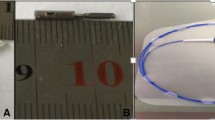Abstract
The use of hemostatic surgical clips is crucial in laparoscopic surgery. Metal clips can cause significant interference with computerized tomography, may have poor holding power, and may erode into important anatomic structures. Polymeric absorbable clips, which have advantages over metallic clips, are evaluated in this study. In vitro and in vivo studies were undertaken to evaluate the hold force, rate of degradation, tissue reactivity and safety of absorbable polymeric clips. Absorbable and titanium clips were applied across excised canine cystic ducts and both axial and transverse pull-off forces were measured. In the second phase, absorbable clips were implanted subcutaneously into male rats and the strength remaining within the clips was measured after 7, 10, 14, or 21 days. In phase 3, 30 pigs were randomized into six groups and each animal underwent a laparoscopic cholecystectomy. The cystic duct and artery were ligated with absorbable polymeric clips (experimental group) or titanium clips (control group). Animals were sacrificed at 7, 14, or 28 days and a celiotomy was performed. Intraabdominal adhesions were assessed and scored.
The force required to dislodge the absorbable clip was significantly greater than for metallic clips for both axial and transverse forces. Absorbable clip strength retention decreased over time as expected with a retention of 11% original strength by the 21st day. Adhesions were highest when bile spillage occurred, but did not differ significantly between either clip type.
Absorbable polymeric clips were hemostatically effective in this laparoscopic model and may offer advantages over metallic clips.
Similar content being viewed by others
References
Allan A, Cooper MJ, Leaper DJ (1984) A new absorbable ligating clip for use in cholecystectomy. J R Coll Surg Edinb 29: 1: 53–54
Dujovny M, Kossovsky N, Kossowsky R, Valdivia R (1985) Aneurysm clip motion during magnetic resonance imaging: in vivo experimental study with metallurgical factor analysis. Neurosurgery 17: 4: 543–548
Gadacz TR, Talamini MA, Lilemore KD, Yeo CJ (1990) Laparoscopic cholecystectomy. Surg Clin North Am 70: 6: 1249–1262
Gelister JSK, King DM, Horwich A, Hendry WF (1991) Imaging properties of polydioxanone and titanium ligating clips following para-aortic lymphadenectomy for testicular cancer. Br J Urol 68: 301–304
Gold JP, Pulsinelli W, Winchester P, Brill PW, Jacewicz M, Isom OW (1989) Safety of metallic surgical clips in patients undergoing high-field-strength magnetic resonance imaging. Ann Thorac Surg 48: 643–645
Grainger DA, Meyer WR, DeCherney AH, Diamond MP (1991) Laparoscopic clips: evaluation of absorbable and titanium clips with regard to hemostasis and tissue reactivity. J Reprod Med 36: 7: 493–495
Gross SC, Kowalski JB, Lee SHH, Terry B, Honickman SJ (1985) Surgical ligation clip artifacts on CT scans. Radiology 156: 831–832
Hovaguimian H, Strom Floten H (1990) Choice of surgical clips for mammary artery take-down. Letter to the editor. Ann Thorac Surg 50: 854–860
Huu N, Vu NH, Barra JA (1987) Resorbable synthetic clips and pulmonary excision: a review of 50 cases. J Chir (Paris) 124/2: 113–118
Janson JA, Cotton PB (1990) Endoscopic treatment of a bile duct stone containing a surgical staple. HPB Surgery 3: 67–71
Nathanson LK, Easter DW, Cuschieri A (1991) Ligation of the structure of the cystic pedicle during laparoscopic cholecystectomy. Am J Surg 161: 350–354
Nelson MT, Nakashima M, Mulvihill SJ (1992) How secure are laparoscopically placed clips? An in vitro and in vivo study. Arch Surg 127: 718–720
New PFJ, Rosen BR, Brady TJ, Buonanno FS, Hister JP, Burt CT, Hinshaw WS, Newhouse JH, Pohost GM, Taveras JM (1983) Potential hazards and artifacts of ferromagnetic and non-ferromagnetic surgical and dental materials and devices in nuclear magnetic resonance imaging. Radiology 147: 139–148
Olsen DO (1991) Laparoscopic cholecystectomy. Am J Surg 161: 339–344
Raoul JL, Bretagne JF, Reignier A, Heresbach D, Campion JP, Gosselin M (1992) Migration of the cystic duct clip into the common bile duct: a complication of laparoscopic cholecystectomy treated by endoscopic sphincterotomy: a report of 4 cases. Gastroenterol Clin Biol 16: A54
Schaefer CJ, Colombani PM, Geelhoed GW (1982) Absorbable ligating clips. Surg Gynecol Obstet 154: 513–516
Weber F (1991) Metallic surgical clips and magnetic resonance imaging. Letter to the editor. Ann Thorac Surg 51: 162
Weese JL, Rosenthal MS, Gould H (1984) Avoidance of artifacts on computerized tomograms by selection of appropriate surgical clips. Am J Surg 147: 684–687
Author information
Authors and Affiliations
Rights and permissions
About this article
Cite this article
Klein, R.D., Jessup, G., Ahari, F. et al. Comparison of titanium and absorbable polymeric surgical clips for use in laparoscopic cholecystectomy. Surg Endosc 8, 753–758 (1994). https://doi.org/10.1007/BF00593434
Received:
Accepted:
Issue Date:
DOI: https://doi.org/10.1007/BF00593434




